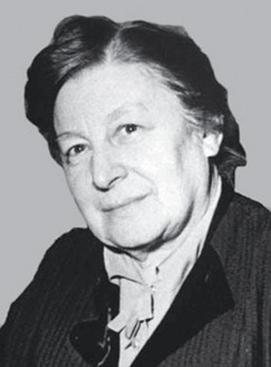
グルニヤ・スチャレヴァ
Grunya Efimovna Sukhareva, 1891-1981

グルニヤ・エフィモヴナ・スチャレヴァ(Груня Ефимовна Сухарева, [ˈɡrunʲə jɪˈʲ suxrɐvə], 別字表記スカレーヴァ) (1891/11 - 1981/4/26[1]) はソ連の児童精神科医であった。1925年に自閉症症状の詳細な記述を初めて発表した[2]。原著はロシア語で、その1年後にドイツ語で出版された。 1996年にスーラ・ウォルフが英語圏向けに翻訳した[3][4]。
| Grunya Efimovna
Sukhareva (Груня Ефимовна Сухарева, [ˈɡrunʲə jɪˈfʲiməvnə
ˈsuxɐrʲɪvə],
alternative transliteration Suchareva) (11 November 1891 – 26 April
1981[1]) was a Soviet child psychiatrist. She was the first to publish
a detailed description of autistic symptoms in 1925.[2] The original
paper was in Russian and published in German a year later. Sula Wolff
translated it in 1996 for the English-speaking world.[3][4] She initially used the term "schizoid psychopathy", "schizoid" meaning "eccentric" at the time, but later replaced it with "autistic (pathological avoidant) psychopathy" to describe the clinical picture of autism. The article was created almost two decades before the case reports of Hans Asperger and Leo Kanner, which were published while Sukhareva's pioneering work remained unnoticed.[5] As Sukhareva’s autism research was translated and published in German-language journals within a year of its domestic publication in Russian, there existed no serious barrier to access of these materials by Asperger and Kanner. The precise reason for her extensive research remaining uncited in the work of these two scientists, however, cannot be precisely determined and is still a matter of discussion by experts.[6] Her name was transliterated as "Ssucharewa" when her papers appeared in Germany, and the autism researcher Hans Asperger likely chose not to cite her work, due to his affiliation with the Nazi Party and her Jewish heritage.[6] |
グルニヤ・エフィモヴナ・スチャレヴァ(Груня
Ефимовна Сухарева, [ˈɡrunʲə jɪˈʲ suxrɐvə], 別字表記スチャレヴァ) (1891/11 -
1981/4/26[1])
はソ連の児童精神科医であった。1925年に自閉症症状の詳細な記述を初めて発表した[2]。原著はロシア語で、その1年後にドイツ語で出版された。
1996年にスーラ・ウォルフが英語圏向けに翻訳した[3][4]。 彼女は当初、「シゾイド・サイコパス」という言葉を使った。「シゾイド」は当時「風変わりな」という意味であったが、後に自閉症の臨床像を表すために「自 閉症的(病的回避性)サイコパス」に置き換えらた。この論文は、スカーレワの先駆的研究が注目されないまま発表されたハンス・アセッパーや レオ・カナーの症例報告より20年近く前に作成された[5] 。スカーレワの自閉症研究は、ロシア語での国内発表後1年以内にドイツ語の雑誌に翻訳出版されており、アセッパーやカナーがこれらの資料にアクセスするの に大きな障害は存在していない。しかし、彼女の広範な研究がこの2人の研究者の研究に引用されなかった正確な理由は不明であり、現在も専門家の間で議論が 続いている[6]。 彼女の論文がドイツで発表されたとき、彼女の名前は「スチャ レワ」と音訳されており、自閉症研究者のハンス・アスペルガーは、ナチ党との関係が あり、彼女のユダヤ人(ないしはスラブ系?)の系譜を引くことから彼女の研究に引用しないことにしたと 思われる[6]。 |
| [6]“There is another, darker
reason why Sukhareva’s work may have been lost for so long, Manouilenko
says. Given the limited number of psychiatry journals at the time, it
is possible that Asperger, for whom Asperger syndrome was named, read
Sukhareva’s paper in German and chose not to cite it. Earlier this
year, historians Edith Sheffer and Herwig Czech independently reported
that they had found evidence of Asperger’s cooperation with the Nazi
Party, and that he may have sent dozens of disabled children to be
euthanized. Sukhareva was Jewish, and Asperger may not have wanted to
give her credit. Manouilenko offers a more benign possibility: Given
Asperger’s position, he may not have been permitted or felt able to
credit Sukhareva.”.- Zeldovich, Lina (7 November 2018). "How history
forgot the woman who defined autism". Spectrum. |
[6]スチャレヴァの研究が長い間行方不明になっていたのには、もう一
つ暗い理由がある、とマヌイレンコは言う。当時の精神医学雑誌の数が限られていたことを考えると、アスペルガー症候群の名前の由来となったアスペルガー
が、スチャレヴァのドイツ語の論文を読み、それを引用しないことにした可能性があるのです」。今年の初め、歴史家のエディス・シェファーとヘルヴィヒ・
チェコが、アスペルガーがナチス党に協力していた証拠を発見し、彼が数十人の障害児
を安楽死させた可能性があると、独自に報告した。スチャレヴァはユダヤ
人であり、アスペルガーは彼女の功績を認めたくなかったのだろう。マヌイレンコはもっと穏当な可能性を提示している。アスペルガーの立場からすると、ス
チャレヴァを信用することは許されなかったし、できなかったのかもしれない。 |
| Biography Sukhareva was born in Kiev to the Jewish family of Chaim Faitelevich and Rachil Iosifovna Sukhareva.[7] Between 1917 and 1921, she worked in a psychiatric hospital in Kiev. From 1921, she worked in Moscow, and from 1933 to 1935 she was leading the department of Psychiatry in Kharkov University (Kharkov Psychoneurological Institute).[2] Sukhareva studied autistic children, and described them in a way which has been compared to the modern description of autism in the DSM 5. She helped open schools for autistic children where they participated in multiple activities, such as gymnastics, drawing, and woodwork.[6] In 1935, Sukhareva founded a Faculty of Pediatric Psychiatry in the Central Institute of Postgraduate Medical Education. In 1938, she led a clinic of childhood psychosis under the Russian SFSR Ministry of Agriculture and Food. For many years, she worked as a councillor and leader of the Psychiatric Hospital of Kashchenko in Moscow.[8] Sukhareva believed that for personality disorders to appear in children and teenagers, a significant social factor was required. Some of the factors she discussed for personality disorders were a poor family environment and societal structure. She was a pioneer in using the method of suggestion, and fought for children's rights, stating that difficult children should not be sent to labor camps, but to medical institutions. She also studied PTSD from war injuries sustained by children.[9] By order of the Moscow Department of Health, the Moscow Scientific and Practical Center for Mental Health of Children and Adolescents was named after Sukhareva, with the prefix G. E. Sukhareva appended to the front. The center is the leading specialized medical institution for the treatment of suicidal states in children and adolescents under 18 years of age.[10] |
略歴 1917年から1921年にかけて、キエフの精神病院に勤務した。1921年からはモスクワで働き、1933年から1935年まではハリコフ大学(ハリコ フ精神神経研究所)の精神科を率いていた[2]。 スチャレヴァは自閉症児を研究し、DSM5における現代の自閉症の記述と比較されるような方法で自閉症児を記述した。彼女は自閉症児のための学校の開設を 支援し、そこで彼らは体操、絵、木工などの複数の活動に参加した[6]。 1935年、スチャレヴァは大学院医学教育中央研究所に小児精神医学部を設立した。1938年には、ロシア連邦農業食糧省のもとで小児精神病の診療所を指 導した。長年にわたり、モスクワのカシチェンコ精神病院の評議員および指導者として働いていた[8]。 スチャレヴァは、パーソナリティ障害が子供やティーンエイジャーに現れるためには、重要な社会的要因が必要であると考えていました。彼女が論じたパーソナ リティ障害の要因のいくつかは、劣悪な家庭環境や社会構造であった。彼女は、暗示の方法を用いた先駆者であり、困難な子どもを労働キャンプに送るのではな く、医療機関に送るべきだと述べ、子どもの権利のために戦いました。また、子供が負った戦争傷害によるPTSDの研究も行った[9]。 モスクワ保健局の命令により、モスクワ児童青少年精神保健科学実践センターはスチャレヴァの名を冠し、接頭辞としてG.E.スチャレヴァが付けられた。こ のセンターは、18歳未満の子供と青少年の自殺傾向の治療のための主要な専門医療機関である[10]。 |
| Sukhareva's patients In 1926 then 1927, Sukhareva described six boys[11] and five girls[12] as having what is now considered autism.[13] These patients are some of the first to be identified as having the disorder.[14] The patients, though anonymous, were described as follows: A 12-year-old who had taught himself to read at age five. He was physically awkward and preferred talking to adults instead of children. He was very interested in philosophy. A gifted violinist who struggled socially. A child with exceptional memory of numbers but with face blindness. A child who had imaginary friends that lived in a fireplace. Source: https://en.wikipedia.org/wiki/Grunya_Sukhareva |
スチャレヴァの患者 1926年と1927年にスカーレワは6人の少年[11]と5人の少女[12]が現在自閉症と考えられているものを持っていると説明した。 これらの患者は自閉症であると確認された最初の患者の一部である。 [14] 患者は匿名だが、以下のように記述されていた。 5歳で読み方を覚えた12歳。彼は身体的に不器用で、子供ではなく大人と話すことを好んだ。哲学に強い関心を持っていた。 ヴァイオリンの才能がありながら、社会的に不利な立場にある。 数字の記憶力は抜群だが、顔が見えない子供。 暖炉の中に住む空想の友達がいた子供。 https://www.deepl.com/ja/translator |
リンク
文献
その他の情報



++
Copyleft,
CC, Mitzub'ixi Quq Chi'j, 1996-2099